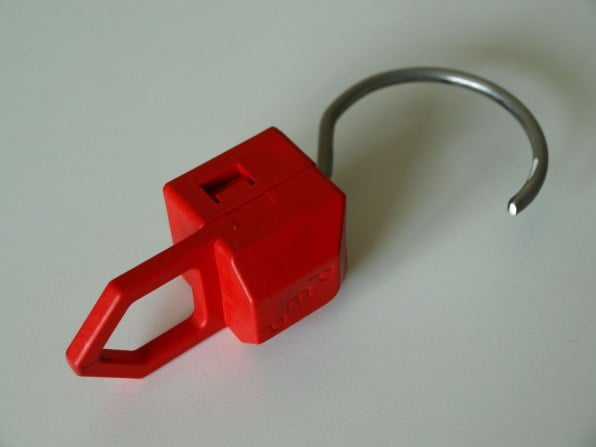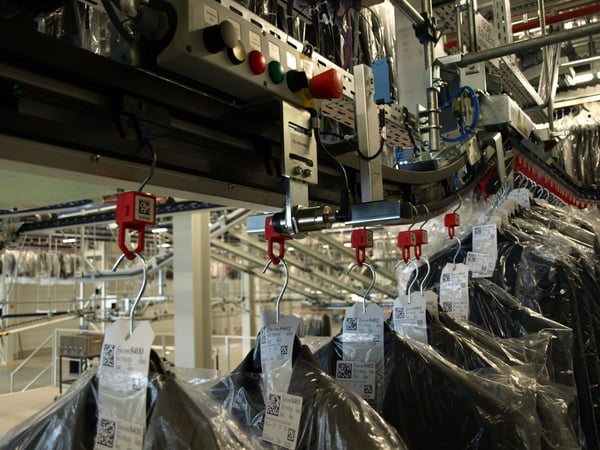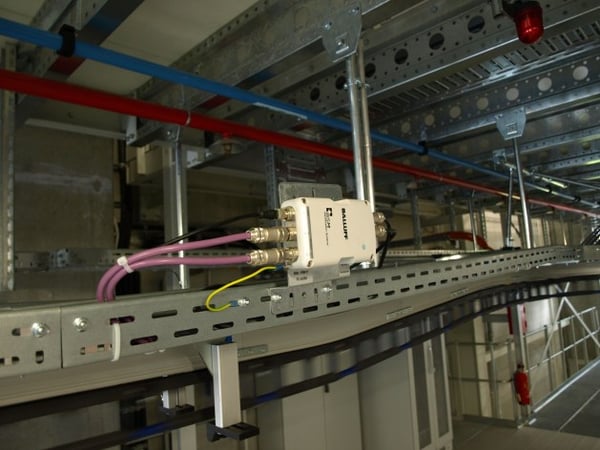In times of globalization and high labor costs it is a challenge to increase competitiveness in the fashion industry. Within a warehouse, an RFID system supports a high degree of automation as well as short transport distances.
To supply dealers and to keep their facility profitable, one of the most successful fashion companies in the world has built a highly modern hanging garment distribution center. Let’s take a look at how they successfully implemented RFID technology to improve their processes.
Separate and sort clothes with just one hybrid module (2D code + RFID)
Within this distribution center 45,000 of these innovative clothes hanger adapters (L-VIS) are used. They replace the previous trolley-based logistics approach by allowing the transportation of a number of different garments that have the same destination.
 L-VIS, clothes hanging adapter made by P.E.P. Fördertechnik
L-VIS, clothes hanging adapter made by P.E.P. Fördertechnik
With the investment in some additional space in the so-called buffer or storage zone, and by providing empty trolleys at various locations to keep the product flow moving, this project is successfully accomplished. A major advantage of this system, is the usability over the entire intralogistics chain. From receiving, to the hanging storage, to the sorter for single item identification, and from there as a transport unit to shipping.
The clothes hanger contains an RFID chip, that is automatically read by the conveying technology, and the 2D-code. This code is read manually by employees with a portable acquisition unit. The code can be DMC (Data Matrix Code), QR-Code, or any other optical code standard.
 HUGO BOSS garment distribution center (Metzingen, Germany)
HUGO BOSS garment distribution center (Metzingen, Germany)
Information exchange without visual contact
A high frequency RFID chip is installed. With this identification system, neither direct alignment nor contact is needed to enable data exchange via nearfield communication. Non-contact identification is extremely reliable and wear-free. The identification system consists of a rugged data carrier, a read/write head and an RFID processor unit. The processor unit communicates to the control system via Profibus, but could be accomplished with ProfiNet or EtherNet/IP as well.
 BIS-M RFID processor unit
BIS-M RFID processor unit
The following table gives you an overview of types of Radio Frequency Identification solutions that are available on the market:
| Common Types | Low Frequency | Low Frequency | High Frequency | Ultra High Frequency |
| Frequency | 70/455 kHz | 125 kHz | 13.56 MHz | 860 … 960 MHz |
| Short description | Dedicated solution to tool identification in Metal-Working industry. | Standard solutions for simple Track & Trace applications. | Fast & reliable – even with high volumes of data in medium distances in assembly, production and intralogistics. | Identification at large distances and bunching capability for current material flow concept. |
For the customer, the decision to choose this particular system among others was the separation between the processor and read/write head. In a widespread facility it would not make sense to have a decoder with 30 read/write heads attached. By interfacing two read/write heads per processor, it is possible to track the travel of a transport unit over the entire conveyor line as well as track within the aisles between the individual shelves.
An additional advantage of the system implemented is the housing options. The L-VIS carrier and the 30 mm read/write head are an ideal match. The simple mounting of the processors and ready-to-use connection were of high value to the system integrators. In the sorting area, a 2D code was supplemented by the RFID tags to reach speeds of up to 0.6 and 0.7 m/s. This would probably not have been possible with the installation of a corresponding camera technology.
Experiences have shown, that RFID projects need a lot of support. Consultation and assistance from true experts can be provided by our team. Learn more about RFID technology here.
























